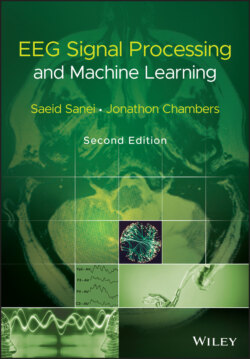Читать книгу EEG Signal Processing and Machine Learning - Saeid Sanei - Страница 55
3.5.2 Models Describing the Function of a Neuron 3.5.2.1 Lewis Neuron Model
ОглавлениеThe Lewis model is based on the Hodgkin–Huxley membrane model and the theories of Eccles on synaptic transmission [59]. The model circuit is illustrated in Figure 3.16. This neuron model is divided into two sections: the synaptic section and the section generating the action pulse. Both sections consist of parallel circuits connected to the nodes representing the intracellular and extracellular sites of the membrane.
Figure 3.15 Circuits simulating (a) potassium and (b) sodium conductances in the Roy membrane model [58].
Figure 3.16 The Lewis neuron model from 1968 [57].
The section representing the synaptic junction is divided into two components: the inhibitory junction and the excitatory junction. The sensitivity of the section generating the action pulse to a stimulus introduced at the excitatory synaptic junction is reduced by the voltage introduced at the inhibitory junction. The section generating the action pulse is based on the Hodgkin–Huxley model which consists of the normal circuits simulating the sodium and potassium conductances, the leakage conductance, and the membrane capacitance. The circuit also includes an amplifier for the output signal. This model may be used in research on neural networks. However, it is actually a simplified version of Lewis's 46‐transistor network having the same form. The purpose of this simplified Lewis model is to simulate the form of the action pulse with moderate accuracy following simple models.
